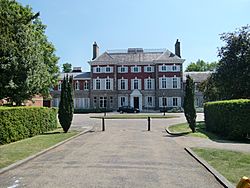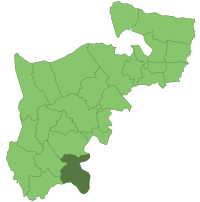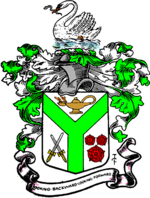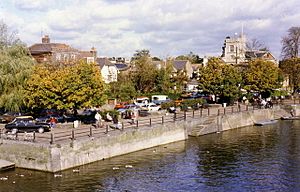Municipal Borough of Twickenham facts for kids
| Twickenham | |
| Motto: Looking Backward, Looking Forward | |
 York House |
|
 Twickenham within Middlesex in 1961 |
|
| Geography | |
| Status | Local board 1868 – 1894 Urban district 1894 – 1926 Municipal borough 1926 – 1965 |
| 1901 area | 2,421 acres (9.8 km2) |
| 1965 area | 7,014 acres (28.4 km2) |
| HQ | Twickenham |
| History | |
| Created | 1868 |
| Abolished | 1965 |
| Succeeded by | London Borough of Richmond upon Thames |
Quick facts for kids Demography |
|
|---|---|
| 1901 population | 20,991 |
| 1961 population | 100,971 |
 Coat of arms of the borough council |
|
Twickenham was a special area in Middlesex, England, that had its own local government from 1868 to 1965. Think of it like a town that managed its own affairs for nearly a hundred years.
The Story of Twickenham's Government
How Twickenham Started Governing Itself
In 1868, Twickenham began to manage its own local services. This happened when the area, which was a civil parish (a small local area), decided to follow a law called the Local Government Act 1858. A group called a "local board" was set up to run things. This board had 27 members who made decisions for the community.
Becoming an Urban District
Later, in 1894, a new law changed how local areas were governed. Twickenham's local board became an "Urban District." This meant it was now run by the Twickenham Urban District Council (UDC). This council had 24 members called "councillors." They were chosen to represent four different parts of the town, called "wards."
Twickenham Becomes a Borough
In 1926, Twickenham became even more important. It was given a special document called a "charter." This made it a "municipal borough." A borough is a town that has a higher level of local government. The borough council now included a mayor (the head of the council), 8 "aldermen" (experienced council members), and 24 councillors. The town was divided into 8 wards.
Growing Bigger: More Areas Join Twickenham
Twickenham grew even larger in 1934. The nearby areas of Hampton, Hampton Wick, and Teddington joined Twickenham. Because of this, the borough council got bigger too. It now had 10 aldermen and 30 councillors, representing 10 wards. Later, the number of wards increased to 11.
Where Decisions Were Made: York House
For a while, the local board met in rented rooms. But in 1881, they moved to Queen's Hall. Then, in 1924, the Twickenham Urban District Council bought a beautiful old building called York House. After some work, York House became the main office for the borough. It was like their town hall.
The End of Twickenham's Own Government
Twickenham's separate local government ended in 1965. This was when a much bigger area called Greater London was created. Twickenham became part of the new London Borough of Richmond upon Thames. Two other areas, Barnes and Richmond, also joined this new borough. Even though Twickenham was no longer a separate borough, York House continued to be an important building. It became the main office for the new London Borough of Richmond upon Thames.
Twickenham's Special Symbol: The Coat of Arms
In 1913, the Twickenham Urban District Council received its own special symbol, called a coat of arms. A coat of arms is like a unique badge for a town or family.
What the Symbols Mean
The name "Twickenham" might mean "two ways" or "two farms." The main part of the shield has a green Y-shape. This shape looks like two roads meeting, showing the "two ways" idea. It also looks a bit like the symbol of the Diocese of Canterbury, which had old connections to the area.
At the top of the shield, there's an old-fashioned lamp. This lamp represents learning, arts, and sciences. On the right side of the shield (called "dexter" in heraldry), there are two crossed swords. These swords are from the symbol of the Diocese of London. They remind us of Twickenham's very first mention in history, when a bishop from London was given land there in the year 704.
The three red roses on the shield come from the symbol of William of Wykeham. He was a person who helped build the tower of the parish church of St Mary in Twickenham back in the 1400s.
The Swan and the Eel
Above the shield, there's a special design called a "crest." This crest shows a swan swimming on water with an eel in its beak. This part of the symbol represents the River Thames, which forms a long border of the town. The eel specifically refers to Eel Pie Island, a famous island in the Thames near Twickenham.
When Twickenham became a municipal borough in 1926, it kept this same coat of arms. It didn't change even when more areas joined the borough in 1934.
Interestingly, the swan from Twickenham's crest was later used as part of the symbol for the new London Borough of Richmond upon Thames when it was formed in 1965.


